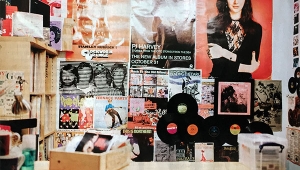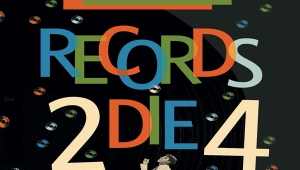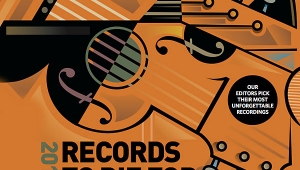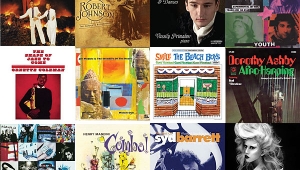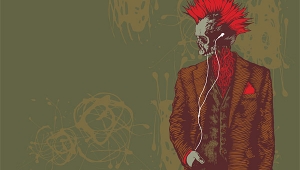| Columns Retired Columns & Blogs |
2007 Records To Die For Page 6
FRED KAPLAN
MILES DAVIS: Kind of Blue
Miles Davis, trumpet; Cannonball Adderley, alto sax; John Coltrane, tenor sax; Bill Evans, Wynton Kelly, piano; Paul Chambers, bass; Jimmy Cobb, drums
Columbia CS 8163 (original "six-eye" or "360 Sound" LP), Columbia/Classic CS 8163 "45 series" (two 45rpm LPs). 1959/1997. Teo Maceo, prod.; Fred Plaut, eng.. AAA. TT: 45:53
JOHNNY RIVERS: L.A. Reggae
BGO BGOCD676 (CD). 1972/2005. Johnny Rivers, prod.; Joe Sidore, eng., mix; Andrew Thompson, remastering. AAD. TT: 42:17
RAMEAU: Une symphonie imaginaire
Excerpts from Zaïs, Castor et Pollux, Les Fêtes d'Hébé, Dardanus, La Temple de la Gloire, Les Boréades, La Naissance d'Osiris, Platée, Hippolyte et Aricie, Les Indes galantes
Marc Minkowski, Les Musiciens du Louvre
Archiv B0004478-02 (CD). 2005. Marita Prohmann, prod.; Mark Buecker, Reinhard Lagermann, engs. DDD. TT: 56:25
LAURIDSEN: Nocturnes
Mid-Winter Songs; Les chansons des roses; I will lift up mine eyes; O come, let us sing unto the Lord; Ave, dulcissima Maria; Nocturnes Stephen Layton, Polyphony, Britten Sinfonia (Mid-Winter Songs); Andrew Lumsden, organ (O come, let us sing unto the Lord); Morten Lauridsen, piano (Les chansons des roses, Nocturnes), finger cymbals (Ave, dulcissima Maria)
Hyperion CDA67580 (CD). 2007. Adrian Peacock, prod.; Simon Eadon, eng. DDD. TT: 67:15
MILES DAVIS: Kind of Blue
Miles Davis, trumpet; Cannonball Adderley, alto sax; John Coltrane, tenor sax; Bill Evans, Wynton Kelly, piano; Paul Chambers, bass; Jimmy Cobb, drums
Columbia CS 8163 (original "six-eye" or "360 Sound" LP), Columbia/Classic CS 8163 "45 series" (two 45rpm LPs). 1959/1997. Teo Maceo, prod.; Fred Plaut, eng.. AAA. TT: 45:53
BILL EVANS: Waltz for Debby
Bill Evans, piano; Scott LaFaro, bass; Paul Motian, drums
Riverside 9399 (original LP), Analogue Productions APJ-009 (LP). 1961/1997. Orrin Keepnews, prod.; David Jones, eng.; Doug Sax, remastering. AAA.
Yes, I know—what a cliché! The two most roasted chestnuts in the genre, so effortlessly crowd-pleasing that one of them, Kind of Blue, remains among the best-selling jazz albums 47 years after its release—and so impervious to saturation among high-end audio denizens that the boutique reissue houses have stamped out as many different pressings of each as the vinylphilic imagination can conjure: 33rpm, 45rpm, 180gm, 200gm, one disc, two discs, four discs... Well, to quote the title of Miles' first track, "So what?" One thing about clichés: sometimes they're true.
Both albums are that rare thing in art: revolutionary breakthroughs that are completely accessible. With Kind of Blue, recorded at Columbia's 30th Street studio in 1959, Miles Davis broke away from the chord-based structures that were the foundation of postwar jazz, supplanted it with church modes, and laid them out on melodic lines and blues improvisations. On Waltz for Debby, recorded live at the Village Vanguard in 1961, Bill Evans perfected the jazz trio: all three parts equal, yet integrated into song forms.
The sound quality is near-perfect. And what great combos! There has never been a more synchronized sextet than on Kind of Blue, or a more seamless piano trio than on Waltz for Debby. Other great jazz albums, I'm more or less in the mood to hear. These two work on so many levels, and are at once so relaxing yet so provocative, that it's hard to imagine tiring of either. (Kind of Blue: XV-2, XIX-2, XX-2, XX-7, XXV-3. Waltz for Debby: XVII-9, XVIII-2, XXIII-9.)
KEN KESSLER
JOHNNY RIVERS: L.A. Reggae
BGO BGOCD676 (CD). 1972/2005. Johnny Rivers, prod.; Joe Sidore, eng., mix; Andrew Thompson, remastering. AAD. TT: 42:17
Ever underrated, the magnetic Johnny Rivers issued albums that, Bobby Darin style, reflected changes in the music scene. This masterpiece predates the height of the Left Coast era, foreshadowing stunners that the players here—L.A. session men including Jim Gordon, Larry Knechtel, and Joe Osborn—would deliver behind the likes of Ronstadt and Raitt. Always showing impeccable taste, Rivers covers "Knock on Wood," "Crazy Mama," "Mother and Child Reunion," and, in incendiary fashion, "Rockin' Pneumonia." By all means find the original vinyl, but this fine-sounding reissue also gives you a second CD that includes the sequel, Blue Suede Shoes (1973).
NUGGETS: Original Artyfacts from the First Psychedelic Era 1965–1968
Various Artists
Rhino UK/Elektra 5101-12419-2 (CD). 1972/2006. Compiled by Lenny Kaye; various prods., engs.; Alan Silverman, remastering. AAD. TT: 76:31
Nuggets has been reissued before, but—the original LPs aside—this brand-new UK edition is the coolest package yet. Containing only the 27 tracks compiled by then–rock-critic Lenny Kaye, it comes in a miniature version of the gatefold LP. Kaye presciently saw the worth of the great garage-band 45s that predated punk by a decade, among them such AM-radio gems as the Standells' "Dirty Water," the Knickerbockers' Beatles-esque "Lies," and treasures from the Nazz, the Remains, and others. Sonically it's a mess, but according to some, this may just be the most influential rock compilation ever.
ROBERT LEVINE
RAMEAU: Une symphonie imaginaire
Excerpts from Zaïs, Castor et Pollux, Les Fêtes d'Hébé, Dardanus, La Temple de la Gloire, Les Boréades, La Naissance d'Osiris, Platée, Hippolyte et Aricie, Les Indes galantes
Marc Minkowski, Les Musiciens du Louvre
Archiv B0004478-02 (CD). 2005. Marita Prohmann, prod.; Mark Buecker, Reinhard Lagermann, engs. DDD. TT: 56:25
It's a pity that Jean-Philippe Rameau never composed purely symphonic music, but conductor Marc Minkowski has come to the rescue: This CD contains 17 excerpts from the composer's operas (actually, 16, with one anonymous orchestration of a keyboard suite), most presented as composed, a couple with their vocal parts removed. Rameau is a really cool, really surprising composer—he'll toss in a chromatic line or introduce a suspension that disturbs momentarily and unexpectedly dazzles the ear. He uses woodwinds to tickle a sense, and his pageant of orchestral colors is vivid and bright. The performances are stunning, the sonics brilliant. Perhaps this will sneak some unsuspecting listeners into examining Rameau's operas. (XXVIII-11)
MOZART: La Clemenza di Tito
Mark Padmore, Tito; Alexandra Pendatchanska, Vitellia; Sunhae Im, Servilia; Bernarda Fink, Sesto; Marie-Claude Chappuis, Annio; Sergio Foresti, Publio; RIAS Kammerchor Freiburger Barockorchester; René Jacobs
Harmonia Mundi HMU 801923.24 (2 CDs). 2006. Dr. Richard Lorber, prod.; René Möller, eng. DDD. TT: 2:15:00
This recent recording of Clemenza beats all the competition for sheer drama alone—it almost makes you care about what's going on. Arias, duets, ensembles, and even the recitatives are dramatically delivered, the pianoforte improvising like a commentator beneath them. Jacobs—his period-instrument Freiburg Baroque Orchestra playing with snap, energy, beautiful wind tone, thwapping timpani, fine brass, and crisp strings—finds just the right tempos (mostly quick) for each piece, and allows the singers plenty of room for embellishments. Mark Padmore's Tito is fluent and well-accented; he makes the most of the Emperor's quandary. Alexandra Pendatchanska is a spectacular Vitellia, taking the role's 21/3-octave range in stride, and singing with a Slavic edge to the voice that underlines the jealousy and looniness of her more outlandish moments. She delivers "Non piu dei fiori" gently and with lovely legato. Bernarda Fink brings great passion—and superb coloratura—to Sesto; she doesn't sound quite manly enough, but she makes the character strong enough with her intelligently inflected singing. The others in the cast are fine artists one and all, and the soundstage is broad and realistic. This is the Clemenza to die for. (XXIX-8)
JOHN MARKS
LAURIDSEN: Nocturnes
Mid-Winter Songs; Les chansons des roses; I will lift up mine eyes; O come, let us sing unto the Lord; Ave, dulcissima Maria; Nocturnes Stephen Layton, Polyphony, Britten Sinfonia (Mid-Winter Songs); Andrew Lumsden, organ (O come, let us sing unto the Lord); Morten Lauridsen, piano (Les chansons des roses, Nocturnes), finger cymbals (Ave, dulcissima Maria)
Hyperion CDA67580 (CD). 2007. Adrian Peacock, prod.; Simon Eadon, eng. DDD. TT: 67:15
I hold these truths to be self-evident: 1) Rainer Maria Rilke was a genius. 2) Morten Lauridsen is a genius. 3) Lauridsen's a cappella setting of Rilke's "Contre Qui, Rose" is one of the most singularly beautiful pieces of vocal music in the history of Western Civilization. 4) Polyphony's new Hyperion recording of "Contre Qui, Rose" is a Record To Die For. (The rest of the disc isn't too shabby, either.)
PAUL DESMOND: Desmond Blue
Paul Desmond, alto sax; Jim Hall, guitar; strings arranged & conducted by Bob Prince
Classic Compact Discs LSPCD 2438 (24-K gold CD). 1961/1997. George Avakian, prod.; Ray Hall, eng. A?D. TT: 37:21
Bluebird/RCA 63898-2 (CD with bonus tracks). 1961/2002. A?D. TT: 66:00
In Concierto, Jim Hall's celebrated 1970s CTI excursion, the master of understated guitar lyricism traded heartfelt solos with Paul Desmond and Chet Baker. Here's a forerunner to Concierto, from the previous decade: Paul Desmond fronting a string section, with Hall featured in a supporting role. Fortunately, Desmond and Hall managed to rise above the cash-in concept. (Gee, is there another jazz record from around that time with "Blue" in its title?) Desmond and Hall's music succeeds despite, rather than because of, Bob Prince's culturally striving string arrangements, which include such nonessentials as a mock-Elizabethan intro to "My Funny Valentine." And the liner notes are just for rueful chuckles. Still, Desmond Blue contains lots of great playing that has stood the test of time. The budget reissue adds alternate tracks and tunes.
- Log in or register to post comments






